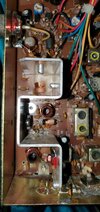I picked up 2 old tube amps. I haven't messed with them much other than I know 1 actually works and as far as, powering it on, and "tuning" it to make sure it had output i haven't done anything with it. I want to play around with it using my TinySA and assume it will need some cleaning up.
Now to the point. Does anyone have a input on making my own bandpass filter? advise, tips, and so on? Or is it just as easy/practical to pick up a ebay premade unit? I did notice that the multi band filters on ebay cover a fairly larger bandwidth than i would need?
I did a search for bandpass but wasn't able to find anything. Sorry if i missed it and asking probably a newbie question.
Now to the point. Does anyone have a input on making my own bandpass filter? advise, tips, and so on? Or is it just as easy/practical to pick up a ebay premade unit? I did notice that the multi band filters on ebay cover a fairly larger bandwidth than i would need?
I did a search for bandpass but wasn't able to find anything. Sorry if i missed it and asking probably a newbie question.

